Trigonostigma heteromorpha (Duncker, 1904)
harlequin rasbora
Trigonon = ( a triangle or hatchet) and Stigma = (a spot or brand)hetero = (differing) morpha = (form); indeed T. heteromorpha can be intuitively observed to be different from T. somphongsi, T. espei and T. hengeli; the latter two can be easily mis-identified as one another.
CONTENT
1. Photographic vouchers and illustration
2. Species description
3. Natural habitat
4. Geographical distribution
5. Nomenclatural Histroy
6. Type species retrieval information
7. Closely related species
8. Phylogenetic inferences
9. Reproductive behaviour
10. Schooling behaviour
11. Genomic informaiton
12. References
1. Photographic vouchers and illustration
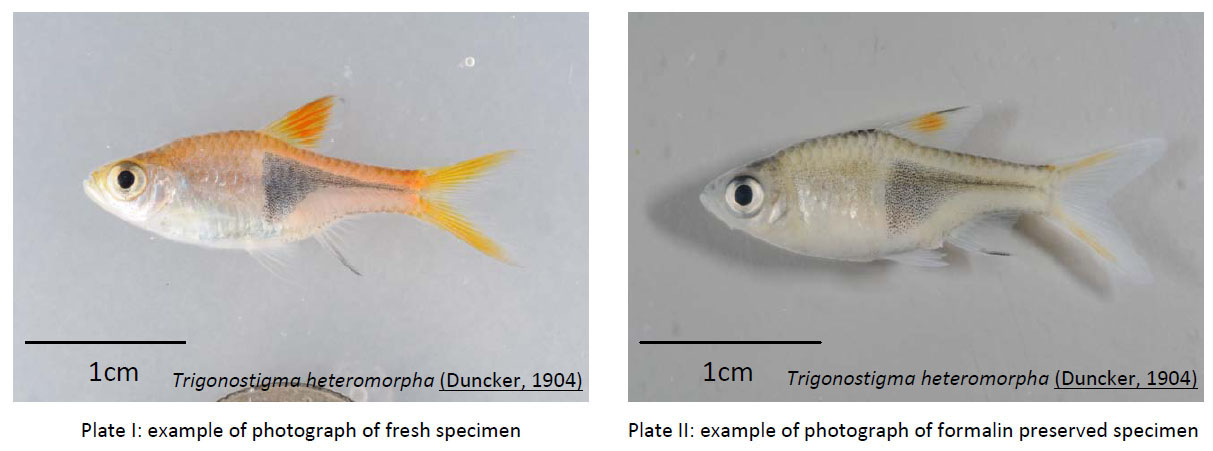
Yi Youguang (C)
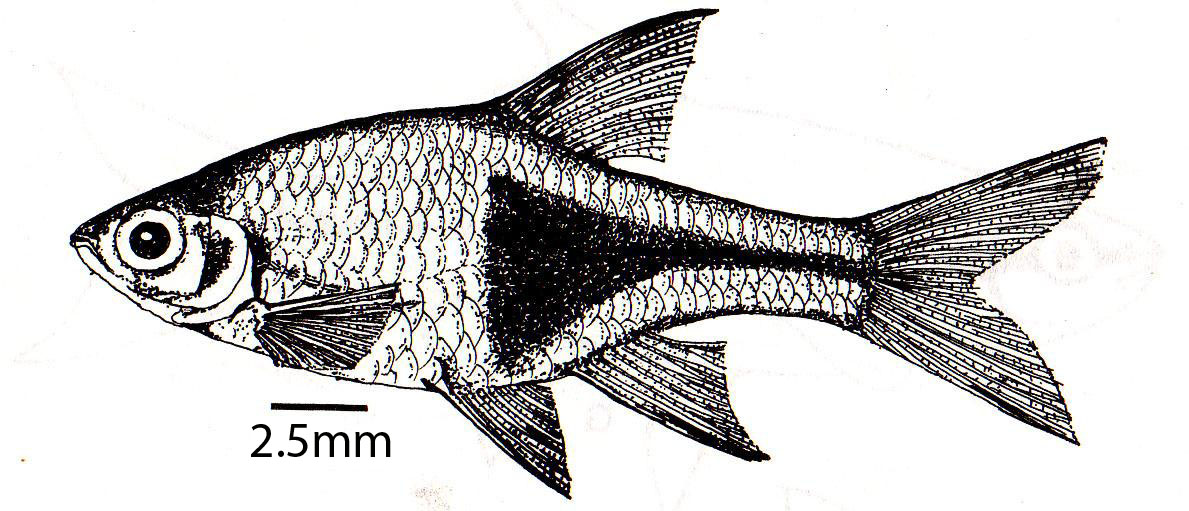
Plate III: Black and white illustration (C) 1983 Penerbit Universiti Pertanian Malaysia

Singapore local postage stamp with an illustration of Trigonostigma heteromorpha.
Go back to content
2. Species description
Trigonostigma heteromorpha was first described by W. Duncker in 1904; the first specimen were from a pond in Singapore Botanical garden. The original description was written in German, and was not made available in English, neither could I obtain the original publication in Singapore. According to Alfred (1966), who slightly mentioned T. heteromorpha in his publication seemed to suggest that Brittan (1954) did a relatively detailed description of T. heteromorpha then Rasbora heteromorpha; most probably the first detailed description in English. Kottelat(1999) did a revision and changed the genus to Trigonostigma, currently the name Trigonostigma heteromorpha is the accepted and valid new name combination. Here, the description is a summary of description from various publication.
Posterior half of the body possesses a broad bluish-black to black area almost representing a triangle (Mohsin, 1983; Kottelat, 1993). The dorsal and ventral side of the triangle runs parallel to the dorsal and ventral side of the body, the apex of the triangle is directed posteriorly up to the caudal peduncle and its base runs downward from below the dorsal origin to a point above the pelvic insertion (Mohsin, 1983).
In terms of identification, the broadness of the triangular blotch serves as a distinct character state that differentiate it from Trigonostigma espei and hengli, which both possess a triangular blotches that are intuitively observed to be smaller than that of heteromorpha. Quantitatively, I would hypothesize that the TB/Body Dept ratio of T. heteromorpha is way above 50%, while that of espei and hengeli is 50% or lesser. TB = Triangle base (here refer to the side that is more or less parallel to the caudal peduncle).
=
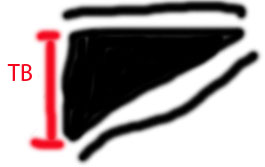
=
Lateral line incomplete (6 - 9 pores), absence of barbels, 5 branched anal rays (Kottelat, 1999). Depth of body less than 3 times in standard length. M a x i m u m size exceeding 20 mm standard length (Brittan, 1954; Mohsin, 1983).
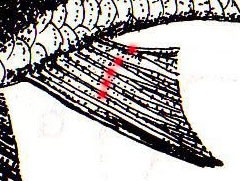 Anal fin count: 1 single + 5 branched
Anal fin count: 1 single + 5 branchedBody deep and short unlike the other slender Rasbora. Dorsal and anal fins are marked with a black tinge. The rest of the fins are hyaline (glass like appearance). It grows to a length of 30-35mm (Mohsin, 1983).
Go back to content
3. Natural Habitat
Trigonostigma heteromorpha are surface to midwater dwellers. They can be found in und in forest streams & major peat swamp. T. heteromorpha are indigenous to Singapore. At present, it survives only in certain small streams (pH = 5 to 6) in the central catchment forest in Singapore, and currently listed as endangered locally (Lim and Ng, 1990).
Go back to content
4. Geographical Distribution
Asia: Malay peninsula (Thailand: Bangkok; Khlong Toh Daeng, Narathiwat; Khlong Sungei Padi southwards to mainland Malaysia) to the main island of Singapore to Sumatra (Indonesia).
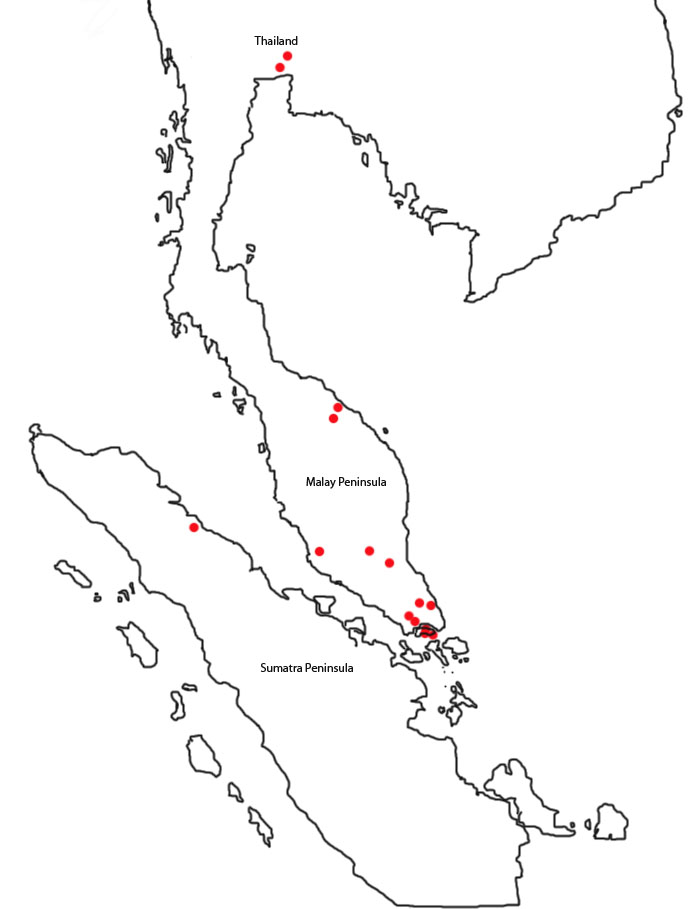
MAP 1: Distribution map of Trigonostigma heteromorpha: (RED DOT = present of T. heteromorpha). This distribution map is plotted based on the information of collected specimens below (table 1); it is a pitty that GPS coordinates were not readily available. Specimen from the trade are not included in the map.
The distribution shows that most of the specimens were actually collected from the Malay Peninsula. Specimen collected from Khlong Toh Deang (Thailand; Bangkok) were not plotted onto the map.
| Country |
Year |
Collector/s |
Catalog no. |
Locality |
|
| Indonesia |
1935 |
Ladiges leg. VII.1935 |
ZMH 15211 |
Medan-Deli, Sumatra |
|
| Malaysia |
1901 |
Duncker leg., ded. 1901 |
ZMH 381 |
Singapore, Malaysia |
|
| Malaysia |
1902 |
Duncker leg., ded. 1902 |
ZMH 380 |
Semunga-Benung , Malaysia |
|
| Malaysia |
1902 |
Duncker leg., ded. 1902 |
ZMH 379 |
Kwala Lumpur, Malaysia |
|
| Malaysia |
1902 |
Duncker leg., ded. 1902 |
ZMH 378 |
Semunga-Benung, Malaysia |
|
| Malaysia |
no year |
Tweedie, M. W. F. |
SU 47267 |
S. Pahang, Tasek Bera |
|
| Malaysia |
no year |
Herre, Albert W. |
SU 39379 |
Johore, near Kulai. |
|
| Malaysia |
no year |
Herre, Albert W. |
SU 34638 |
Mawai Dist., Johore. |
|
| Malaysia |
no year |
Herre, Albert W. |
SU 31204 |
Mawai Dist., 50-60 miles north of Singapore. |
|
| Malaysia |
no year |
Tweedie, M. W. F. |
SU 31203 |
Gunong Pulai. |
|
| Malaysia |
1963 |
Lindsey, C.C.; Aborigines |
??? |
MALAYA PAHANG TASEK BERA (SWAMP LAKE), central Malay Peninsula. |
|
| Singapore |
no year |
Herre, Albert W. |
SU 34639 |
Mandai Road. |
|
| Thailand |
no year |
Roberts, Tyson R. |
CAS 94619 |
Khlong Sungai Padi 12-13 km north of Sungai Padi town. |
|
| Thailand |
no year |
Roberts, Tyson R. |
CAS 94195 |
Khlong Toh Daeng at Ban Toh Daeng, 3 km due north of Sungai Golok town. |
|
| Thailand |
no year |
Roberts, Tyson R. |
CAS 94186 |
Peat swamp forest 12 km southwest of Tak Bai. |
ZMH = Zoological Museum of Hamburg
SU & CAS = California Academy of Science, Ichthyology Collection
Go back to content
5. Nomenclatural History
Rasbora heteromorpha is the original name that was being used when it was first described by W. Duncker in 1904 (please note that the original description of Rasbora heteromorpha (Duncker, 1904) was written German language and not available in library within Singapore).
The earliest reference with a brief species description of Rasbora heteromorpha that is accessible and written in English is in the book Freshwater fishes of Singapore by Eric R. Alfred in 1966. According to Eric (1966), Rasbora heteromorpha was first described from specimens taken from Kuala Lumpur; Negri Sembilan and Singapore; lake in the Botanical Garden.
According to the information provided by the catalog of fishes (CAS), Duncker deposited most of the specimen he collected into the Zoological Museum of Hamburg (ZMH), however no holotype was designated, eventually he designate one of the specimen he collected from Semunga-Benung, Malaysia as the lectotype, which I personally think is the holotype. One of the paralectotype was deposited in the Zoologisch Museum, Amsterdam (ZMA).
The specimens that were being observed by Alfred (1966) were actually those collected by R. Hanitsch in 1912, N. Smedley in 1927 and Alfred himself in 1963 and 1966. He also had a chance to observe the 3 paratypes that were being deposited in the Zoologisch Museum, Amsterdam in 1901.
Most of these type specimens observed by Alfred (1966) were being deposited in the National Museum, Singapore. Subsequently, zoological specimen were transferred from the National Museum, Singapore, to the National University of Singapore, and these are currently being curated in the Raffles Museum of Biodiversity Research (NUS).
Kottelat (1999) did a re-description of Rasbora heteromorpha, and placed R. hetermorpha, R. hengeli, R. espei and R. somphongsi into the genus Trigonostigma; more of a genus hypothesis. Individuals placed in the genus Trigonostigma exhibit unique breeding behaviour during which eggs are spawned at the underside of broad leaves and similar structures. This unique spawning behavior differentiates individuals in Trigonostigmafrom the rest in the genus Rasbora. In the latter, the eggs are spawned in mid-water or among plants, for example Rasbora dorsiocellata spawns on the upper surface of submerged leaves close to the water surface (Wickler, 1976).
Go back to content
6. Type Specimen Retrieval Information
Legend:
NMS = National Museum, Singapore;
Z M A = Zoologisch Museum, Amsterdam;
B M = British Museum (Natural History), London;
M L = Rijksmuseum van Natuurlijke Historie, Leiden.
ZMH = Zoological Museum of Hamburg
| Museum Accession No. |
Collector name |
Date Collected |
Locality |
Specimen Status |
Number of specimen |
| ZMH381 |
G. Duncker |
1901 |
Singapore, Malaysia |
Syntype or paralectotype |
2 |
| ZMH380 |
G. Duncker |
1902 |
Semunga-Benung , Malaysia |
Syntype or paralectotype |
22 |
| ZMH379 |
G. Duncker |
1902 |
Kwala Lumpur, Malaysia |
Syntype or paralectotype |
1 |
| ZMH378 |
G. Duncker |
1902 |
Semunga-Benung, Malaysia |
Lectotype |
1 |
| ZMA103218 |
G. Duncker |
1901 |
23 milestone, Semenyih-Beranang Road, Selangor |
Syntype or Paralectotype |
3 |
| NMS1058 |
R. Hanitsch |
16.5.1912 |
Pond near Peirce Reservoir |
4 |
|
| NMS1059 |
N. Smedley |
1927 |
Mandai |
2 |
|
| NMS1168 |
E. Alfred |
4.4.1963 |
Sungei Seletar, north of Seletar Reservoir |
2 |
|
| ML24974 |
E. Alfred |
8.4.1963 |
Sungei Seletar, west of Seletar Reservoir |
2 |
Table 2: Specimen retrieval information
Go back to content
7. Closely related species
 "Trigonostigma hengeli" (Meinken, 1956); Miss Slytherin (C)
"Trigonostigma hengeli" (Meinken, 1956); Miss Slytherin (C)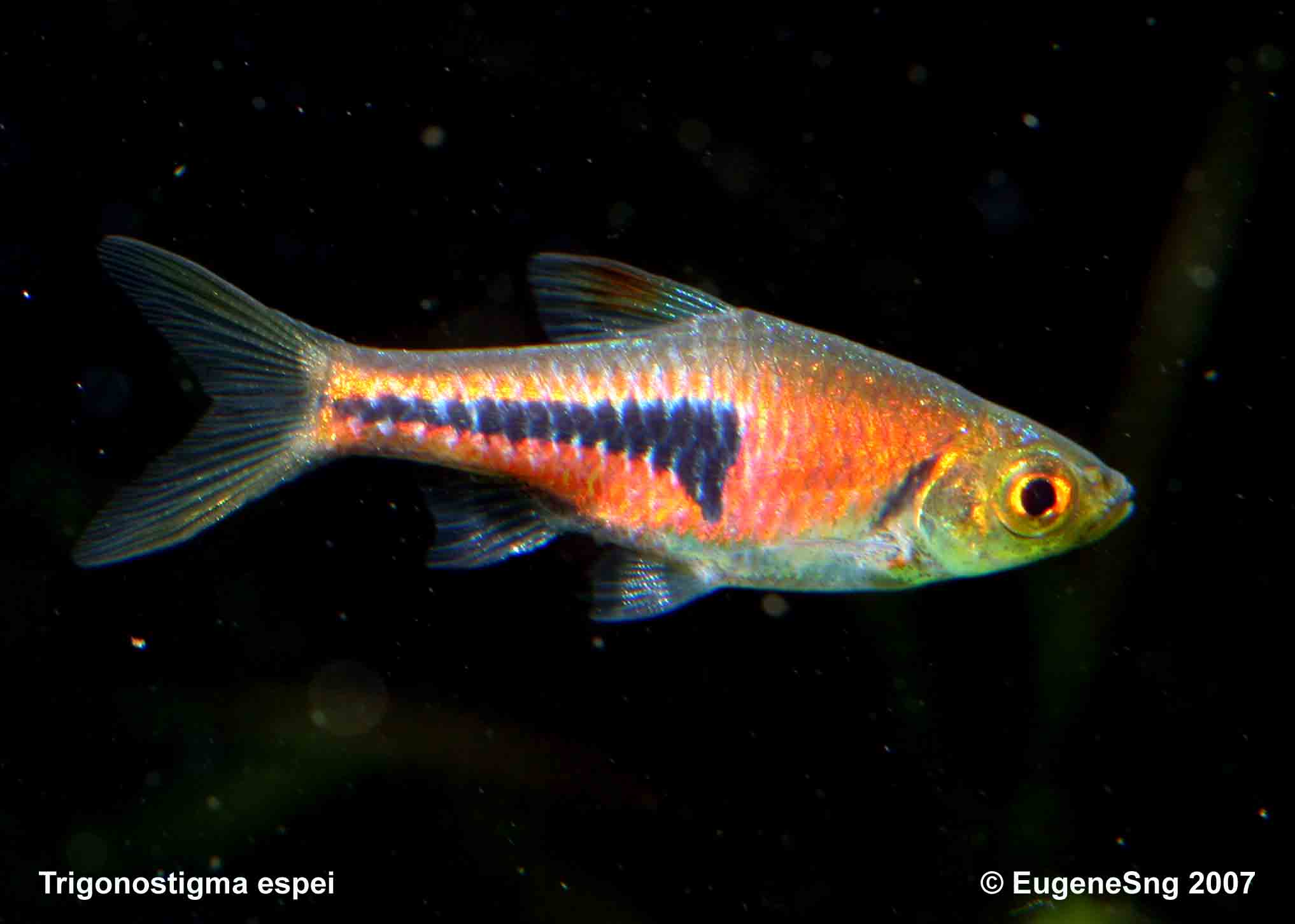
Trigonostigma espei" (Meinken, 1967); Eugene Sng (C)
 "Trigonostigma somphongsi" (Meinken, 1958); http://www.fish-rybakof.narod.ru/tom1b001.htm
"Trigonostigma somphongsi" (Meinken, 1958); http://www.fish-rybakof.narod.ru/tom1b001.htmGo back to content
8. Phylogenetic inference
It is important for systematists and taxonomists to realize that names above the species level are generally not objective and are mainly the result of following the Linnaean classification system, hence genus boundary can be subjective. Nevertheless, there are evidence that the genus Trigonostigma is monophyletic.
The genus Trigonostigma was being introduced by Kottelat and Witte (1999) as a genus hypothesis (refer to Nomenclatural History above). This separation was made on the basis of the spawning method that differs from all other rasbora; in these four species, the female attaches the eggs to the underside broad leaves, and the male comes along to fertilize them. Other species of rasbora are egg scatterers. Subsequent studies (Conway, 2005) have confirmed this division on the basis of phylogenetics except for T. somphongsi.
Trigonostigma somphongsi is distinguished from the other species of the genus in having a more slender body and (somehow related to body depth), a lateral stripe only slightly broader anteriorly, without the conspicuous triangular or hatchet shape, and in missing the dark leading edges of the dorsal and anal fins. As it shares the other characters of the genus, including the unique spawning behaviour, it is placed in Trigonostigma. Future research may show that it is the sister species to all its congeners.
Phylogenetic inferences using 34 morphology characters (Conway, 2005) and DNA (Rupert et al, 2011) further shown congruence that Rasbora heteromorpha, R. hengeli and R. espei are indeed monophyletic, and hence the hypothesis that the genus Trigonostigma is objective do make make sense, except for the missing information regarding T. somphongsi.

The above is part of a neighbour joining tree based on cytochrome oxidase subunit 1 DNA sequence showing the monophyly of the Trigonostigma genus, this group is nested in the larger Rasbora clade. This definitely shows us that genus boundary is subjective, however if the phylogenetic concept is being applied, Trigonostigma is defintely a monophyletic group according to this piece of information. Cladogram based on morphological characters have also shown that the Trigonostigma is a monophyletic group (Refer to Figure 1 & 2 below) (Conway, 2005).
There are currently no data regarding phylogenetic relationship of the Trigonostigma somphongsi to the rest of the species within this group, except for those provided by Kottelat and witte (1999).
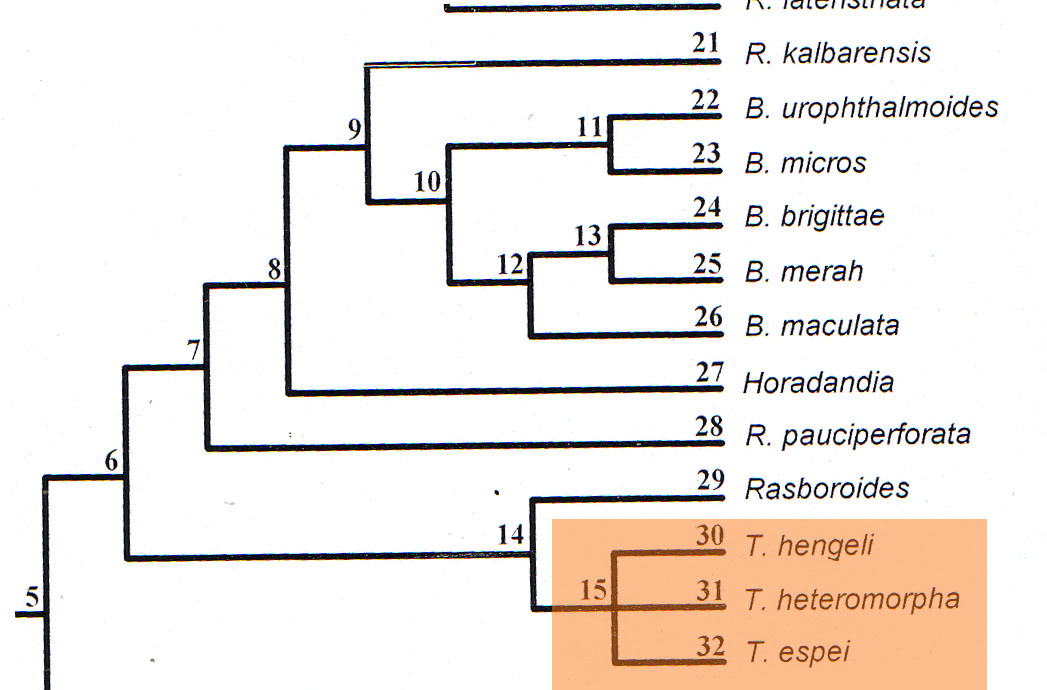
Figure 1: One of the 30 most parsimonious cladogram generated (Conway, 2005). (Conway (C) )
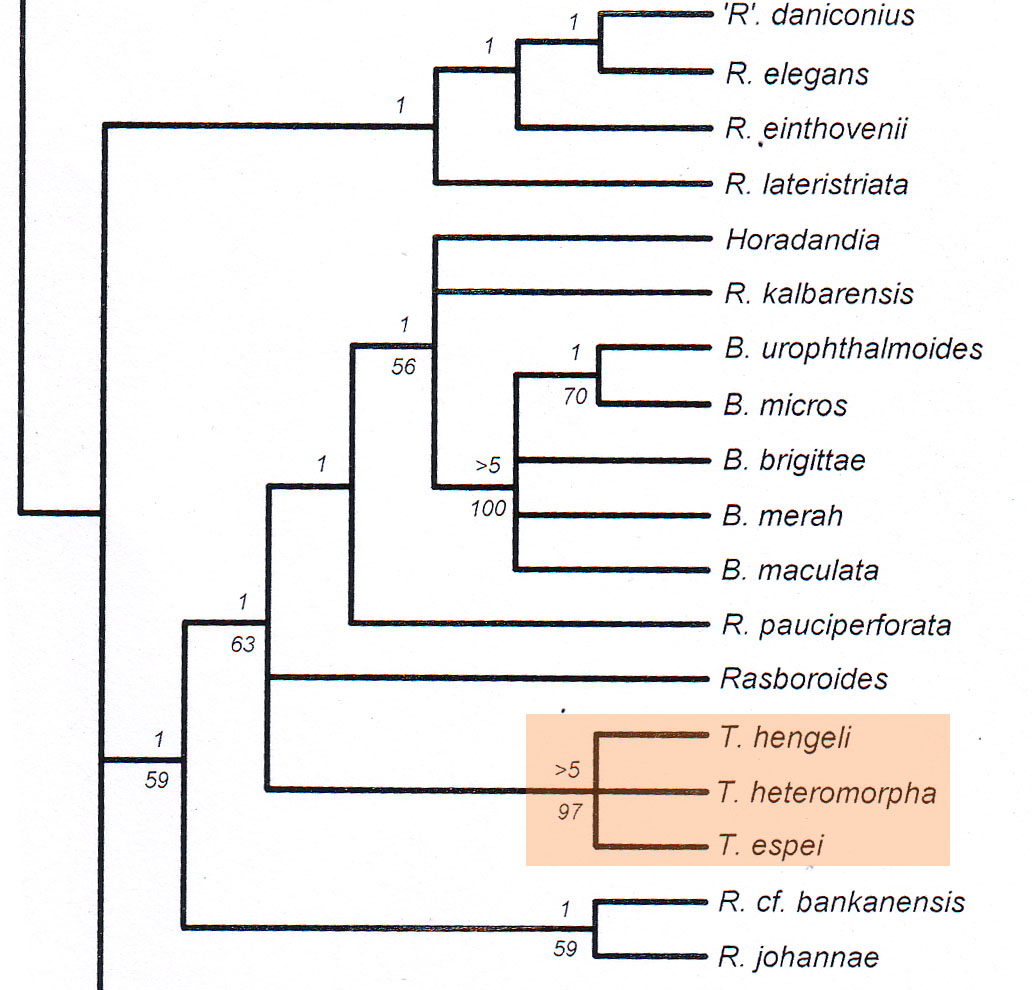
Figure 2: Consensus cladogram gnerated (Conway, 2005). (Copy right (C))
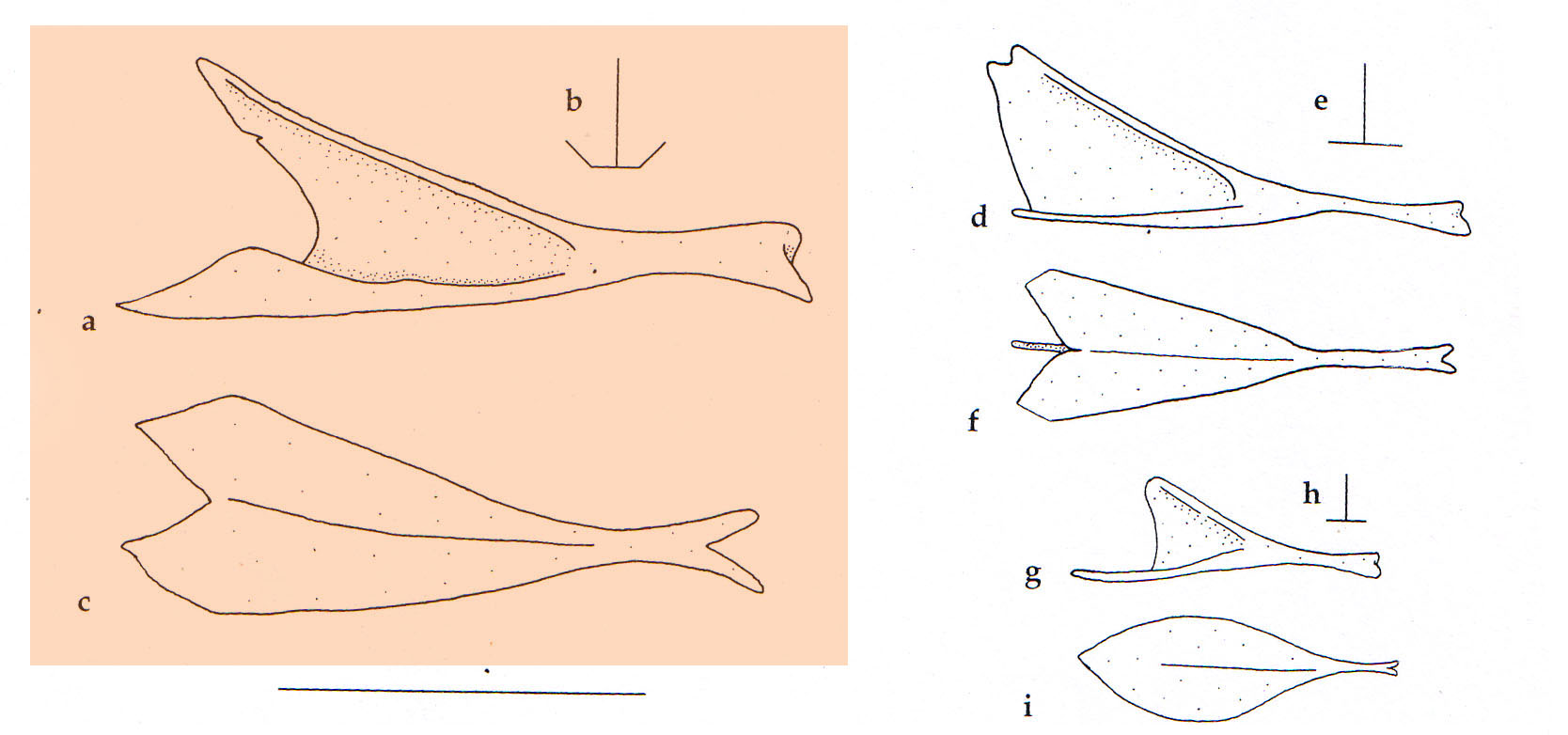
Figure 3. Urohyal bone of T.heteromorpha V.S that of other Rasbora spp.; a) right side lateral view, b) Schematic cross-section of (a), c) ventral view.
d) to i) are Urohyal bones of other Rasbora spp. (Conway, 2005) Conway (C).
According to Conway (2005), The ventral flanges of the urohyal* in Trigonostigma heteromorpha, T. hengeli & T. espei have curved edges, causing the base of the urohyal to appear 'boatshaped' in cross section (3a). In all remaining taxa the ventral flanges of the urohyal are flat and without curved edges. Compare figure 3a with 3e & 3h to have a better picture. This character state (curved edges of the ventral flanges of the urohyal) is observed to be the only synapomorphy in the characters that Conway (2005) had used that define the genus Trigonostigma.
*Urohyal: median and posterior elements in the hyoidean arch of fishes (In simple terms, it's a piece of bone for lower jaw muscle attachment).
Go back to content
9. Reproductive Behaviour
Eggs spawned at the underside of broad leaves and similar structures (Kottelat, 1999). The female attaches the eggs to the underside broad leaves, and the male comes along to fertilize them.
Video 1: A pair of Trigonostigma heteromorpha breeding in aquarium; exhibition of oophagy
Video 2: Trigonostigma heteromorpha breeding in aquarium; a closer view
The videos above shows us the spawning behaviour of T. heteromorpha. Note that the other three species within the genera also exhibit similar spawning behaviour.
Go back to content10. Schooling Behaviour
Thines (1966) studied the schooling behaviour of T. heteromorpha in the presence of alarm substances in-vitrolly (substances secreted by the epidermis of fish when they are under threat, eg. upon observing the presence of predator.).
The general findings from this paper suggests that schooling density in T. heteromorpha is higher in the presence of light, and lower in darkness, irregardless of presence or absence of alarm substances.
Trigonostigma heteromorpha do not respond to alarm substances during night time, it was observed that schooling density do not increase at night when alarm substances were introduced, in fact schooling density decreased in darkness even when alarm substances was introduced.
Trigonostigma heteromorpha is more responsive to alarm substances in the presence of light, as indicated by increase in schooling density, this suggest that phobic reaction spreads more easily when optic information is available in T. heteromorpha.
Go back to content11. Genomic Information
Chromosome numbers
- N = 24, 2N =48
Please use the Genbank Accession numbers below to search for the related DNA sequences.
COI sequences:
- Accession: JF915697.1, GI:353078603
- Accession: JF915696.1, GI:353078601
- Accession: JF915695.1, GI:353078599
Mitochondrial genome (Partially complete, lacking the D-Loop):
- Accession: AP011421.1, GI:332887000
Go back to content
12. References
- D U N C K E R , G., 1904. Die Fische der malayischen Halbinsel. — Mitt, naturh. Mus. Hamburg 21: 133207, map ι, textfig. ι, pl. 1, 2
- Conway, K.W. 2005. Monophyly of the Genus Boraras. Ichthyological Exploration of the Freshwater 16 (3), 249-264.
- Duncker, G. 1904. Die Fische der malayischen Halbinsel. Mitt. Naturhist. Mus. Hamburg21: 133-207.
- MHD Mohsin A. K. and MOHD Azmi A. 1983. Freshwater Fishes of Peninsular Malaysia. Page 50.
- Lim K. P. & Ng K. L. 1990. A Guide to Freshwater Fish of Singapore. ( http://habitatnews.nus.edu.sg/guidebooks/freshfish/text/203.ht )
- Alfred E. R. 1966. Freshwater Fish of Singapore. Page 10, 11, 17, 19.
- Kottelat, M. and K.E. Witte. 1999. Two new species of Microrasbora from Thailand and Myanmar, with two new generic names for small Southeast Asian cyprinid fishes (Teleostei: Cyprinidae). J. South Asian Nat. Hist. 4(1):49-56.
- Thines & Vandenbussche. 1966. The effect of alarm substance on the schooling behaviour of Rasbora heteromorpha (Duncker, 1904) in day and night conditions. Animal Behaviour 14, 296 - 302. doi:10.1016/S0003-3472(66)80086-6
Go back to content
| Subject | Author | Replies | Views | Last Message |
|---|---|---|---|---|
| Trigonostigma heteromorpha (Harlequin Rasbora) | 0 | 104 |
Nov 8, 2011 by |